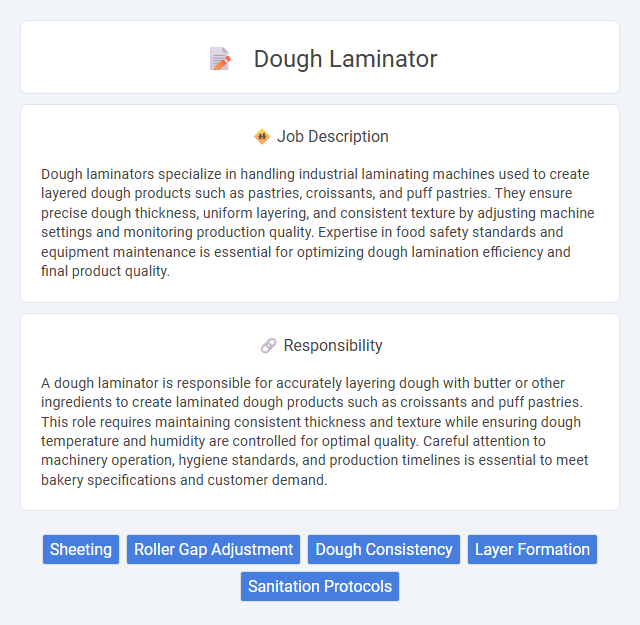
Dough laminators specialize in handling industrial laminating machines used to create layered dough products such as pastries, croissants, and puff pastries. They ensure precise dough thickness, uniform layering, and consistent texture by adjusting machine settings and monitoring production quality. Expertise in food safety standards and equipment maintenance is essential for optimizing dough lamination efficiency and final product quality.
Individuals with good physical stamina and manual dexterity are likely to be well-suited for a dough laminator job, as the role frequently involves repetitive motions and standing for extended periods. Those who are comfortable working in a fast-paced, food production environment may have a higher probability of success in this position. However, people with severe allergies to gluten or other baking ingredients might find the working conditions challenging.
Qualification
A dough laminator must possess expertise in operating and maintaining industrial laminating machines to ensure consistent dough thickness and texture, requiring technical skills in machine calibration and troubleshooting. Candidates should have a background in food production or bakery processes, with knowledge of hygiene standards and safety regulations essential for maintaining product quality and compliance. Strong attention to detail and physical stamina are critical, as the role demands precision in handling dough layers and sustaining high productivity in fast-paced manufacturing environments.
Responsibility
A dough laminator is responsible for accurately layering dough with butter or other ingredients to create laminated dough products such as croissants and puff pastries. This role requires maintaining consistent thickness and texture while ensuring dough temperature and humidity are controlled for optimal quality. Careful attention to machinery operation, hygiene standards, and production timelines is essential to meet bakery specifications and customer demand.
Benefit
Using a dough laminator likely improves production efficiency by consistently creating uniform dough layers, reducing manual labor and time. It may also enhance product quality through precise control over dough thickness and texture, leading to better final baked goods. Investing in this equipment could result in cost savings by minimizing waste and increasing overall output consistency.
Challenge
Dough laminator jobs may present challenges such as maintaining consistent dough thickness and texture during high-speed production, requiring precise calibration and attention to detail. Operators might also encounter difficulties in managing dough temperature and humidity levels to prevent tearing or sticking. Proper training and experience could improve the likelihood of overcoming these obstacles effectively.
Career Advancement
A dough laminator plays a crucial role in the food production industry by expertly layering dough to create pastries, croissants, and other bakery products. Mastery of lamination techniques and understanding of dough properties can lead to supervisory roles or specialized positions in industrial pastry production. Career advancement opportunities often include becoming a production manager, quality control specialist, or culinary instructor in bakery sciences.
Key Terms
Sheeting
Dough laminators excel in the sheeting process, which involves rolling dough into uniform, thin layers essential for consistent texture and baking performance. This precision sheeting ensures optimal dough thickness and elasticity, enhancing the quality of pastries, croissants, and other laminated products. Advanced dough laminators feature adjustable rollers and automated controls to maintain consistent sheet dimensions, reducing waste and improving production efficiency.
Roller Gap Adjustment
Precise roller gap adjustment is critical in dough laminator operation to ensure even dough thickness and consistent lamination quality. Proper calibration reduces dough tearing and improves product uniformity, directly impacting bakery production efficiency. Technicians regularly monitor and fine-tune the roller gap to maintain optimal pressure suited to different dough types and recipes.
Dough Consistency
Maintaining precise dough consistency is critical when operating a dough laminator to ensure uniform lamination and optimal bread texture. The dough's hydration level and elasticity directly influence the laminator's performance and the final product's flakiness. Consistent dough thickness achieved through proper laminator calibration enhances product quality and reduces waste during processing.
Layer Formation
A dough laminator precisely folds and rolls dough sheets to create multiple thin layers essential for pastries like croissants and puff pastry. The process involves controlled temperature and consistent pressure to achieve uniform layer separation, enhancing flakiness and texture. Efficient layer formation directly influences dough elasticity and baking performance, making machine calibration critical for optimal product quality.
Sanitation Protocols
Dough laminator operators must strictly follow sanitation protocols to prevent contamination and ensure food safety. Regular cleaning and sanitizing of equipment, work surfaces, and tools are essential to meet FDA and USDA standards in commercial bakeries. Proper hygiene practices, including handwashing and use of gloves, reduce the risk of microbial hazards during dough lamination processes.
 kuljobs.com
kuljobs.com